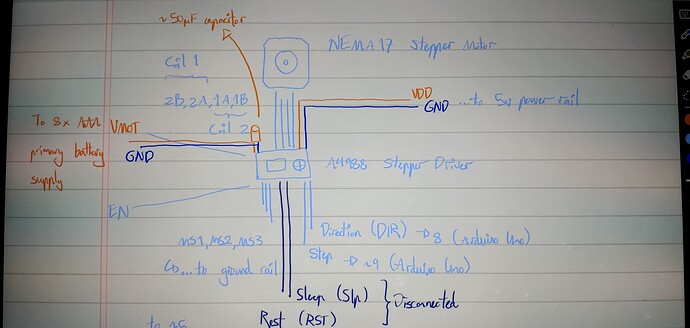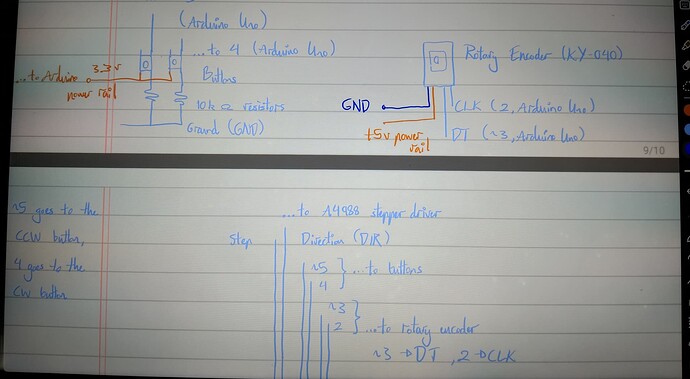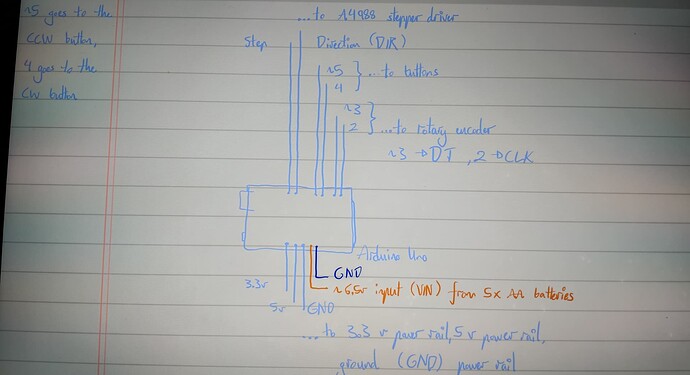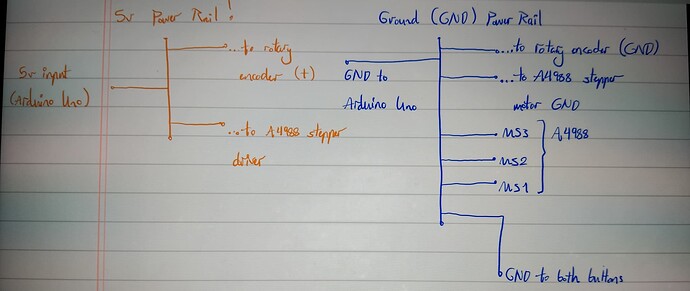I'm trying to control a NEMA17 stepper motor using two buttons, a rotary encoder and an A4988 stepper motor driver using the following code:
//Rewritten to not include the display
#include <AccelStepper.h>
AccelStepper stepper(1, 9, 8);// pulses Digital 9 (CLK); Direction Digital 8 (CCW)
//Defining pins
const int RotaryCLK = 2; //CLK pin on the rotary encoder
const int RotaryDT = 3; //DT pin on the rotary encoder
const int ButtonCW = 4; //Button for clockwise rotation
const int ButtonCCW = 5; //Button for counterclockwise rotation
//Defining variables
int RotateCounter = 0; //initial position
int MotorSpeed = 100; //some default value for steps/s
//Statuses
int CLKNow;
int CLKPrevious;
int DTNow;
int DTPrevious;
// Time
float TimeNow1;
float TimeNow2;
void setup(){
Serial.begin(9600);
pinMode(2, INPUT_PULLUP); //we use the internal pullup resistor
pinMode(3, INPUT_PULLUP);
pinMode(4, INPUT); //CW button
pinMode(5, INPUT); //CCW button
//Store states
CLKPrevious = digitalRead(RotaryCLK);
DTPrevious = digitalRead(RotaryDT);
attachInterrupt(digitalPinToInterrupt(RotaryCLK), rotate, CHANGE);
stepper.setMaxSpeed(2000); //SPEED = Steps / second
stepper.setAcceleration(5000); //ACCELERATION = Steps /(second)^2
TimeNow1 = millis(); //Start time
}
void loop(){
//The motor only runs when one of the buttons are kept pressed
CheckButtons(); //Checking the status of the buttons
RunTheMotor(); //Running the motor
TimeNow2 = millis();
if(TimeNow2 - TimeNow1 > 200) //if the time difference is more than 200 ms (increase the number to print to the LCD less often)
{
TimeNow1 = millis();
}
}
void RunTheMotor() //function for the motor
{
stepper.enableOutputs(); //enable pins
stepper.moveTo(RotateCounter); //tell the stepper to move to the 'RotateCounter'steps (absolute) position
while(stepper.distanceToGo() != 0)
{
stepper.setSpeed(MotorSpeed);
stepper.runSpeedToPosition();
// Serial.print("DistanceToGo: "); //for debugging
// Serial.println(stepper.distanceToGo());
delay(5);
}
Serial.println(MotorSpeed); //for debugging
delay(5);
}
void CheckButtons()
{
Serial.println(digitalRead(ButtonCW)); //Just for debugging
delay(50);
if(digitalRead(ButtonCW) == HIGH) //if the button is pressed
{
RotateCounter += 16;
//increase the value of the variable, this represents the absolute position of the stepper
Serial.print("ButtonCW: "); //for debugging
Serial.println(stepper.distanceToGo());
delay(5);
//you can add delay here which is also a type of debouncing. It is useful when you want to click the button
//once and increase the steps (value of RotateCounter) only by one.
delay(5); //Simplest thing to be able to use this function to add just 1 step at a time to use delay
}
Serial.println(digitalRead(ButtonCCW)); //Just for debugging
delay(5);
if(digitalRead(ButtonCCW) == HIGH)
{
RotateCounter -= 16; //decrease the value of the variable, this represents the absolute position of the stepper
Serial.print("ButtonCCW: "); //for debugging
Serial.println(stepper.distanceToGo());
delay(5);
}
}
void rotate()
{
CLKNow = digitalRead(RotaryCLK); //Read the state of the CLK pin
// If last and current state of CLK are different, then a pulse occurred
if (CLKNow != CLKPrevious && CLKNow == 1)
{
// If the DT state is different than the CLK state then
// the encoder is rotating CCW so increase
if (digitalRead(RotaryDT) != CLKNow)
{
MotorSpeed += 10;
}
else
{
// Encoder is rotating CW so decrease
MotorSpeed -= 10;
}
stepper.setSpeed(MotorSpeed); //as this functions is not started from the loop() it is maybe good to update the speed here
}
CLKPrevious = CLKNow; // Store last CLK state
}
The motor doesn't operate, and the serial monitor constantly outputs the distance to go as 0. What do I do??



